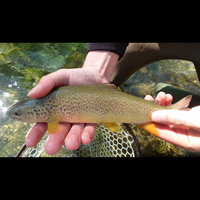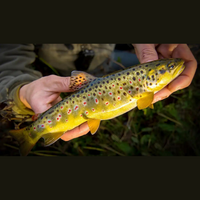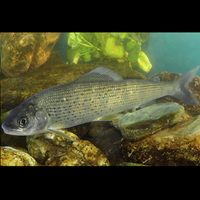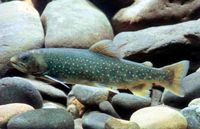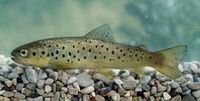Italy's Native Salmonids: Species Profiles.
Italy hosts one of Europe’s richest arrays of native trout and salmonid species. Glacial history, complex geography, and the peninsula’s position between the Adriatic and Tyrrhenian basins created distinct evolutionary lineages and several endemic species.This page presents the native Italian salmonids recognized today, following the most recent scientific and conservation consensus.
Salmo Carpio.
- Range & Habitat: Endemic to Lake Garda in northern Italy, where it occupies deep, cold, well-oxygenated waters between 100–200 m depth. It is one of Europe’s few salmonids adapted to a pelagic lake lifestyle.
- Appearance & Size: Slender, silvery trout with faint or absent spotting; slightly forked tail. Adults typically 30–45 cm, occasionally exceeding 60 cm.
- Behaviour: Pelagic and plankton-feeding for most of its life.
- Life Cycle: Spawns twice annually, a rare trait among salmonids, typically in winter and again in summer on gravel or rocky lake bottoms at depths of 50–100 m.
- Conservation & Threats: Critically Endangered due to overfishing, eutrophication, and introduction of non-native species that compete for plankton or prey on juveniles. Captive-breeding programs (coordinated by Regione Lombardia and local research institutes) aim to preserve the last pure genetic stock and support habitat recovery in Lake Garda.
Salmo Cettii.
- Range & Habitat: Endemic to a few rivers of southeastern Sicily, notably the Alcantara, Simeto, and Anapo systems.
- Appearance & Size: Small to medium trout (15–30 cm). Distinctive pre-opercular spot, persistent parr marks forming a striped pattern, and irregular red and black spots without halos.
- Behaviour: Resident and highly site-faithful, feeds mainly on aquatic invertebrates.
- Life Cycle: Spawns in winter or early spring; juveniles develop in shallow spring-fed reaches.
- Conservation & Threats: Critically Endangered (IUCN). Genetic studies show close relation to North-African trout (S. macrostigma complex). Fewer than 3 % of remaining populations are genetically pure.
Threats include genetic introgression, water abstraction, drought, and fragmentation. Conservation focuses on securing ecological flows, protecting spring habitats, and prohibiting all stocking.
Salmo Fibreni.
- Range & Habitat: Endemic to the small Lake Posta Fibreno (Lazio region, central Italy), a karstic spring-fed lake of only ~0.3 km². It occupies deep spring outlets and clear cold channels.
- Appearance & Size: Small, silvery trout (15–25 cm) with delicate spotting and pale fins. Morphologically distinct from other Italian trout due to its short head and deep body.
- Behaviour: Resident and non-migratory. Diet composed mainly of zooplankton and aquatic insects.
- Life Cycle: Spawns within the lake near spring sources.
- Conservation & Threats: One of Europe’s most range-restricted vertebrates. Threatened by habitat alteration, groundwater extraction, eutrophication, and introgression from stocked trout. Listed as Critically Endangered (IUCN) and protected within the Lago di Posta Fibreno Natural Reserve. Conservation focuses on genetic safeguarding and maintenance of natural spring flows.
Salmo Ghigii.
- Range & Habitat: Native to the Western Alps, Northern and Central Apennines, Sardinia, and Corsica. Occurs in cold, well-oxygenated headwaters and mid-mountain streams with stable flow.
- Appearance & Size: Typically 20–35 cm, with fine dark and red spotting on a bronze to olive background; often shows parr marks along the flanks even in adults.
- Behaviour: Resident, strongly territorial; feeds mainly on aquatic invertebrates.
- Life Cycle: Spawns from late autumn to winter in gravel riffles. Fry utilize shallow margins and spring areas.
- Conservation & Threats: Designated as the true native Mediterranean trout of continental Italy (Polgar et al., 2022; Lorenzoni et al., 2019). Major threats: hybridization with Atlantic S. trutta, habitat modification, illegal stocking. Conservation actions include genetic monitoring, creation of “pure strain” refuges, habitat reconnection, and ecological-flow restoration within the National Plan for Native Trout Conservation.
Salmo Marmoratus.
- Range & Habitat: Native to the northern Alpine rivers draining to the Adriatic: Po, Adige, Brenta, Piave, Tagliamento, and Isonzo basins. Occurs in cold, clear, fast-flowing rivers and in deep pre-alpine lakes connected to those systems.
- Appearance & Size: Known for its pale olive or grey base colour overlaid with irregular, worm-like marbled markings. Can exceed 120 cm and weigh over 20 kg, though most fish range between 40–70 cm.
- Behaviour: A solitary and highly territorial ambush predator. Juveniles feed on aquatic invertebrates; adults are piscivorous and often occupy deep pools or cover.
- Life Cycle: Spawning takes place in late autumn or early winter (Nov–Jan) in small, clean tributaries with gravel bottoms. Young fish hatch in early spring and disperse downstream.
- Conservation & Threats: Main threat is genetic introgression with brown trout. Habitat fragmentation and flow alteration reduce viable populations. Several conservation programs maintain genetically pure broodstocks for restocking within native catchments.
Salmo Trutta (Danubian).
- Range & Habitat: Found naturally in the northernmost Italian drainages connected to the Danube basin, Gail headwaters around Tarvisio, Drava headwaters around Innichen and Inn headwaters around Livigno.
- Appearance & Size: Golden-brown to olive in colour with red and black spots, often surrounded by pale halos. Commonly 35–50 cm; trophy fish can exceed 70–80 cm in large rivers.
- Behaviour: Opportunistic and adaptable. Feeds on insects, crustaceans, and small fish. Holds in riffles, undercut banks, and behind structure.
- Life Cycle: Spawns in late autumn (Oct–Dec) in clean, shallow gravel beds of tributaries. Eggs incubate over winter; fry emerge in early spring.
- Conservation & Threats: The native Danubian strain has declined due to stocking of non-native Atlantic strains. Current efforts aim to restore native genetics in wild populations through selective breeding and stocking.
Salvelinus Umbla.
- Range & Habitat: Occurs in deep, cold, oligotrophic lakes of the Central and Eastern Alps—notably Lakes Garda, Maggiore, Como, Iseo, Molveno, and Tovel—and in some high-altitude reservoirs of Lombardy and Trentino-Alto Adige.
- Appearance & Size: Elongate body with small head and reddish to orange belly during spawning. Adults typically 25–50 cm, though larger fish occur in deep lakes.
- Behaviour: Cold-water species inhabiting profundal and pelagic zones.
- Life Cycle: Spawns in late autumn or winter on coarse-gravel littoral areas or inflowing streams.
- Conservation & Threats: Sensitive to warming, eutrophication, and overfishing. Conservation requires maintaining deep-lake oxygen levels, protecting spawning substrates, and avoiding non-native introductions that alter lake food webs.
Thymallus Aeliani.
- Range & Habitat: Once widespread in the Adriatic drainages of northern Italy and Slovenia, including the Adige, Brenta, Piave, Tagliamento, and lower Isonzo systems.
Today, genetically pure populations remain in only two known locations, both within the Po River drainage, representing the last natural refuges of the original Adriatic grayling lineage in Italy.
These populations inhabit cold, well-oxygenated medium-altitude rivers with clean gravel beds. - Appearance & Size: Very similar to European grayling but less colourful and body proportions are a little different. Adults typically measured 25–40 cm, with occasional individuals reaching up to 45 cm.
- Behaviour: Insectivorous and surface-oriented feeder, especially during hatches. Favoured structured runs and moderate flow.
- Life Cycle: Spring spawner (Mar–May), using similar habitats as European grayling. No known surviving pure populations.
- Conservation & Threats: Almost extinct in its pure form due to hybridization with introduced Danubian grayling. The remnant populations are of exceptional conservation value, representing the last pure Adriatic grayling lineage in Italy.
